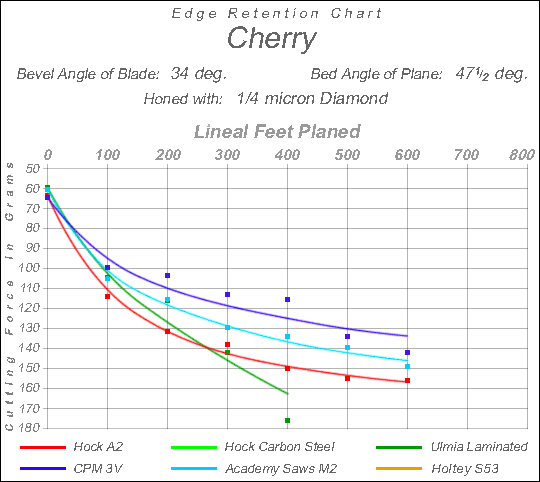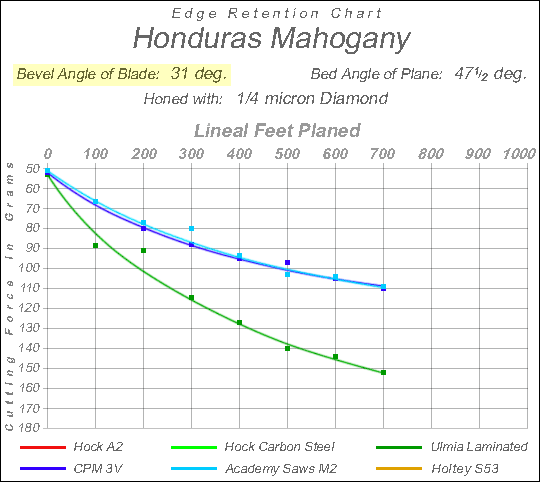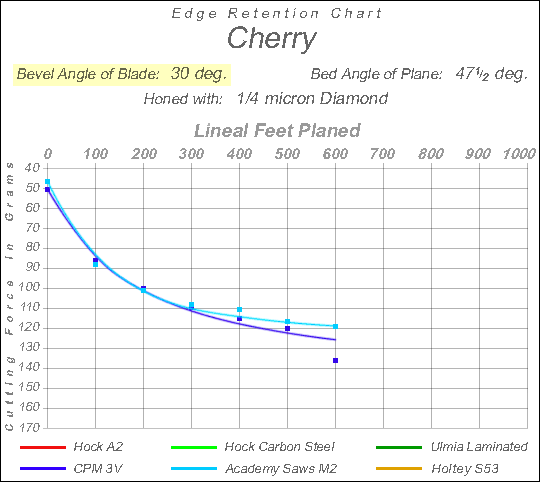To determine how large a bevel angle was needed to prevent edge failure, I began my testing using angles as low as 25º. All of the blades showed serious chipping or deformation after even moderate use on soft woods. I increased the bevel angle until problems were minimal for most of the blades, which was at 34º.
Some of the blades have consistently resisted chipping and deformation at this angle, so I have begun testing more acute angles to see if the blades will show better initial sharpness and edge retention. The first tests suggest that the more acute angles do result in better performance.
During the tests below, I started using a piece of Honduras mahogany as my test piece. The mahogany is somewhat softer than the cherry I was using, so direct comparison of wear results at different bevel angles won’t be possible until I redo the tests that were done using cherry.
For clarity, the charts below are ordered by decreasing bevel angle. Here’s the chart for my usual bevel angle of 34º:


This test convinced me I needed to cut a larger number of loops of thread to reduce the experimental error. The data points fall too far from the curves that are supposed to link them. I’ll do this test again cutting fourteen loops instead of seven for each sharpness test, but for now I’m posting these results.
Here’s my evaluation of the blades based on microscope images of the edges at each stage of the test, and on my subjective judgment:
- The Hock A2 blade chipped too much to be used at this acute an angle.
- The Academy Saws M2 blade and the CPM 3V blade were almost indistinguishable in performance, both rating very well.
- The blades that didn’t chip at this angle started out sharper than when they were honed at 34º and continued to be sharper during the wear test.
Note: Since I did this test I’ve reconsidered my statement that the A2 blade was unacceptably chipped. The chips were on the order of .001” or so and might be unacceptable during a thin-shaving competition, but for most practical woodworking they wouldn’t be much of a problem. The increased edge life of a blade at this lower bevel angle might be worth accepting a few very small chips.
The test below at 31º is being done using fourteen loops for each sharpness test. (This test is underway.)
Despite the similar sharpness results for M2 and CPM 3V in this test, my subjective evaluation of the performance of the blades is that the 3V is holding its edge better. I’m still not satisfied that the thread tests are a good indicator of sharpness for all blade and bevel angle combinations.

The microscope images of the blade edges after each 100 lineal feet of this test can be seen in this composite image which was made using my original 200x microscope.
The test below for a bevel angle of 30º was also done using fourteen loops of thread for each sharpness test.

At this acute an angle, both of the blades showed very small chips, not enough to leave much of a track on the surface of the wood, but enough to suggest that this might be too acute an angle for any wood harder than cherry. The thread test results were very similar to the results for 32º and the microscope images showed a wear surface that was a little wider for the 30º test, so I believe no performance advantage is gained for these blades by decreasing the bevel angle to 30º